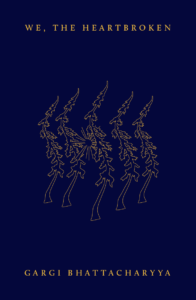
[Hajar Press; 2023]
These years—before, and now in the ongoingness of the pandemic—have been a time of collective reckoning with grief, loss, and sorrow. The loss of loved ones to ill health. The outbreak of wars. Disasters, climate catastrophes. The slow leaching away of political possibility, the closings of what-could-have-beens. In this time of knowledge and connection, prompting what others have called “compassion fatigue,” “doomscrolling,” or “burnout,” it is tempting to turn away from the news, to attempt to disengage. Gargi Bhattacharyya asks us, instead, to consider how these griefs might allow for new kinds of ties and recognition. We can see each other; we can feel with another. They ask how we might understand our individual privations as part of a greater collective loss, and what this could allow for. Heartbreak unmakes us, and in doing so, might allow us to conceive of a remaking of the world itself.
We, the Heartbroken structures itself around the well-known five phases of grief, each of which operates as a leaky container in the book. We join the author in wandering through them: jolted from one to the other, and back to another stage. Shock, denial, anger, bargaining, depression, testing, acceptance. Bhattacharyya shows us how heartbreak encompasses all these feelings but is not bounded by them. We bump up against them and are bruised by them, in the delirium of loss. We return to anger when we are also bargaining; we despair while denying. The book deftly complicates any sense of the linearity of loss, but honors the wisdom the phases offer us in understanding how people navigate heartbreak.
In dealing with grieving, the tone is often wry, honest, and tongue-in-cheek. Old jokes, family ghost stories, fables about Hindu and Greek goddesses, magic spells, inherited memories, children’s movie plots are all wittily reinterpreted, shoring up how art and human memory tell us fundamental truths about mortality and our visions for the future, even in the most unexpected ways. Moving from meditation to storytelling, we accompany the writer through the unruliness of narrating heartbreak in this conversing with the self. The book plays with the possibilities of the creative form, allowing for comedy and a certain bad-temperedness to come through, always conscious of the risks of taking one’s enterprise too seriously. Bhattacharyya lets this seep into our reading, remarking when they think they are being “unkind,” “objectionable,” or “ridiculous.”
Bhattacharyya says—but immediately cautions that it is partly as a joke, partly as provocation—that “heartbrokenness [i]s the class consciousness of racial capitalism.” Their academic work demonstrates how capitalism racializes, divides, and makes us unknowable to one another; they assert that the beast of capitalism is “nothing but pain.” Heartbrokenness is then inevitable in this system of expropriation. It is a function of our division from one another, how solidarity becomes harder to conceive of. But heartbreak is both a general and a specific condition. Griefs are unequally distributed, on some people and bodies more than others. Bhattacharyya also urges us to consider how the sorrows of those who are subjugated express hope for another world too, how grief might point to another way of relating to each other.
It is this tension between individual grief and collective heartbreak that animates the book, and which is left unresolved. Grief unmakes us, we become “unbounded.” “Grief is greedy” too. It demands its specialness and can draw us further within ourselves, instead of letting us go outwards beyond the self. In this way, grief is an awful lot like love, which can be greedy too, pushing us into the object of our desire rather than suffusing the world with possibility. How do we go from one to the other? How do we allow for our skins to be “thinned,” from seeing only our pain to situating it within a larger collective grief? In seeking to avoid being prescriptive, the book risks leaving the necessary movement from individual loss to revolutionary possibility incomplete.
Perhaps this stems from the author’s unwillingness to imbue grief with meaning, or to extoll its uses. Bhattacharyya hints at the vast multitude of griefs and losses we face in our lives—including the political, and the romantic. Bhattacharyya curiously remarks that their conception of heartbreak is not romantic loss, which they consider to be a “proxy” for grief, although they immediately turn this on its head, observing that this might be “cruel” in denying the real pain of lost love. Instead, the heartbreak this book is preoccupied with is the loss of loved ones to “death or illness or disaster.” And so, unlike Audre Lorde’s famous 1981 essay, “The Uses of Anger,” which considers the place of anger in generating energy for change, in allowing Black women to speak honestly, Bhattacharyya warns against the idea that grief can be made useful or meaningful, arguing that this is a delusion. This hesitation runs through the book. Understandably so: Too often we are told celebratory stories of resilience in the face of pain that denies grief’s proper place, that seeks to repackage trauma as triumph. The book remains alive to the ways in which the fullness of grief is at risk of being domesticated through acceptance, and how attempting to impose narrative order on heartbreak is to attempt to make the senseless make sense.
And yet, pointing to the revolutionary possibilities of seeing each other’s heartbreak is to give grief a kind of meaning, if not a use. The demand is to make heartbreak “a thing of the past,” to be in communion with each other’s pains and to ask for nothing less than a remaking of the world. Bhattacharyya writes, at the very end, of how solidarity allows us to be attentive to and alive to our linked futures, our inevitable interdependencies. This gives heartbreak an imaginative capacity, the potential for generative energy in our affinities with each other.
The mistake may be in reading the book as a singular treatise. The phases of the book move back and forth, as does the voice of the writer. In dialoguing and arguing with itself, and challenging its own observations and criticisms, the book remains attentive to complexity. Occasionally this means that the book gestures in the direction of a movement, instead of venturing towards it. The point, perhaps, is to feel our way through these muddy waters together: to look to the horizon, even if we might not yet know how to row. The dialogic form, by turns chiding and reassuring, allows us to see that we are in this leaky boat together.
In naming the radical possibility of heartbreak, and in making visible the affective condition of our time, it calls upon us all to make room for each other’s irreducible humanness. We, the Heartbroken reckons with loss and grief’s fullness and its surprising abilities to make us alive to one another, to be entranced by one another again. We are called upon to do this work, to allow for heartbreak to engender capaciousness and collectivity. As Nina Simone reminds us, in the opening song to the book’s playlist, everything must change. All we have is each other.
Shruti Iyer is a researcher and writer living between India and the UK. Her current project is on workers’ rights and health in contemporary India. She tweets at @salem_steel.
This post may contain affiliate links.







